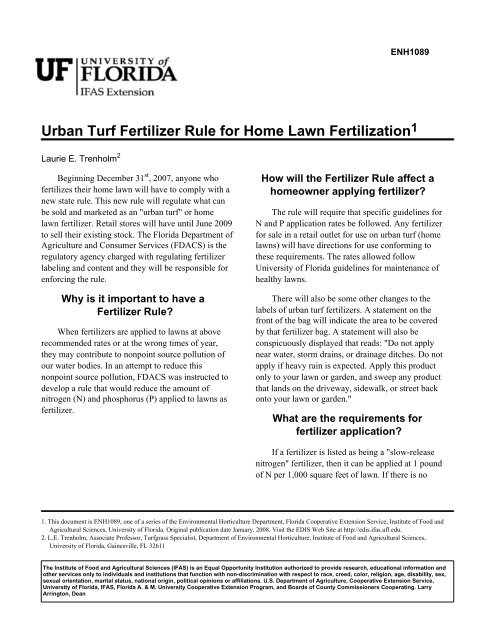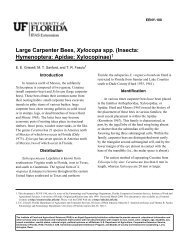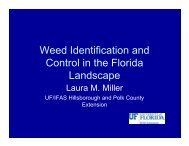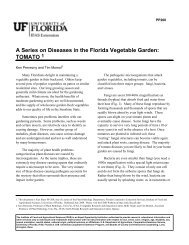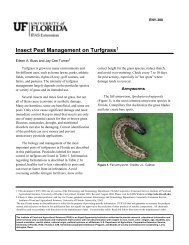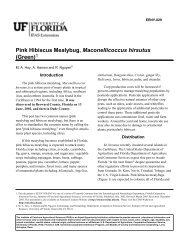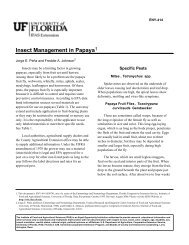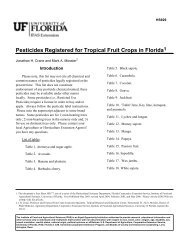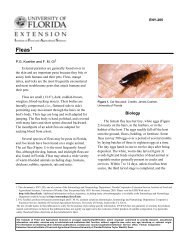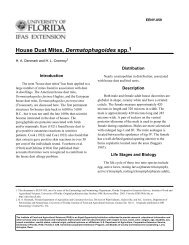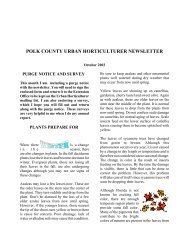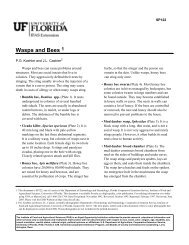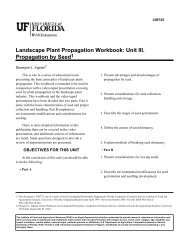Urban Turf Fertilizer Rule for Home Lawn Fertilization - Polk County ...
Urban Turf Fertilizer Rule for Home Lawn Fertilization - Polk County ...
Urban Turf Fertilizer Rule for Home Lawn Fertilization - Polk County ...
You also want an ePaper? Increase the reach of your titles
YUMPU automatically turns print PDFs into web optimized ePapers that Google loves.
ENH1089<br />
<strong>Urban</strong> <strong>Turf</strong> <strong>Fertilizer</strong> <strong>Rule</strong> <strong>for</strong> <strong>Home</strong> <strong>Lawn</strong> <strong>Fertilization</strong> 1<br />
Laurie E. Trenholm 2<br />
Beginning December 31 st , 2007, anyone who<br />
fertilizes their home lawn will have to comply with a<br />
new state rule. This new rule will regulate what can<br />
be sold and marketed as an "urban turf" or home<br />
lawn fertilizer. Retail stores will have until June 2009<br />
to sell their existing stock. The Florida Department of<br />
Agriculture and Consumer Services (FDACS) is the<br />
regulatory agency charged with regulating fertilizer<br />
labeling and content and they will be responsible <strong>for</strong><br />
en<strong>for</strong>cing the rule.<br />
Why is it important to have a<br />
<strong>Fertilizer</strong> <strong>Rule</strong><br />
When fertilizers are applied to lawns at above<br />
recommended rates or at the wrong times of year,<br />
they may contribute to nonpoint source pollution of<br />
our water bodies. In an attempt to reduce this<br />
nonpoint source pollution, FDACS was instructed to<br />
develop a rule that would reduce the amount of<br />
nitrogen (N) and phosphorus (P) applied to lawns as<br />
fertilizer.<br />
How will the <strong>Fertilizer</strong> <strong>Rule</strong> affect a<br />
homeowner applying fertilizer<br />
The rule will require that specific guidelines <strong>for</strong><br />
N and P application rates be followed. Any fertilizer<br />
<strong>for</strong> sale in a retail outlet <strong>for</strong> use on urban turf (home<br />
lawns) will have directions <strong>for</strong> use con<strong>for</strong>ming to<br />
these requirements. The rates allowed follow<br />
University of Florida guidelines <strong>for</strong> maintenance of<br />
healthy lawns.<br />
There will also be some other changes to the<br />
labels of urban turf fertilizers. A statement on the<br />
front of the bag will indicate the area to be covered<br />
by that fertilizer bag. A statement will also be<br />
conspicuously displayed that reads: "Do not apply<br />
near water, storm drains, or drainage ditches. Do not<br />
apply if heavy rain is expected. Apply this product<br />
only to your lawn or garden, and sweep any product<br />
that lands on the driveway, sidewalk, or street back<br />
onto your lawn or garden."<br />
What are the requirements <strong>for</strong><br />
fertilizer application<br />
If a fertilizer is listed as being a "slow-release<br />
nitrogen" fertilizer, then it can be applied at 1 pound<br />
of N per 1,000 square feet of lawn. If there is no<br />
1. This document is ENH1089, one of a series of the Environmental Horticulture Department, Florida Cooperative Extension Service, Institute of Food and<br />
Agricultural Sciences, University of Florida. Original publication date January, 2008. Visit the EDIS Web Site at http://edis.ifas.ufl.edu.<br />
2. L.E. Trenholm, Associate Professor, <strong>Turf</strong>grass Specialist, Department of Environmental Horticulture, Institute of Food and Agricultural Sciences,<br />
University of Florida, Gainesville, FL 32611<br />
The Institute of Food and Agricultural Sciences (IFAS) is an Equal Opportunity Institution authorized to provide research, educational in<strong>for</strong>mation and<br />
other services only to individuals and institutions that function with non-discrimination with respect to race, creed, color, religion, age, disability, sex,<br />
sexual orientation, marital status, national origin, political opinions or affiliations. U.S. Department of Agriculture, Cooperative Extension Service,<br />
University of Florida, IFAS, Florida A. & M. University Cooperative Extension Program, and Boards of <strong>County</strong> Commissioners Cooperating. Larry<br />
Arrington, Dean
<strong>Urban</strong> <strong>Turf</strong> <strong>Fertilizer</strong> <strong>Rule</strong> <strong>for</strong> <strong>Home</strong> <strong>Lawn</strong> <strong>Fertilization</strong> 2<br />
slow-release N in the fertilizer, then it can only be<br />
applied at 0.7 pounds of N per 1,000 square feet.<br />
Most of the retail fertilizers sold <strong>for</strong> use on lawns<br />
have slow-release N in them. Annual N rates can be<br />
found in Table 1 <strong>for</strong> the various lawn grasses in<br />
different regions of the state. For examples of how<br />
many pounds of fertilizer per 1,000 square feet this<br />
calculates to be, go to Table 2.<br />
Application of P is limited to 0.25 pounds of<br />
P 2<br />
O 5<br />
per 1,000 square feet <strong>for</strong> any single application<br />
and no more than 0.50 pounds of P 2<br />
O 5<br />
per 1,000<br />
square feet annually. This means that you may see<br />
"no-phosphate" or "low-phosphate" fertilizers.<br />
<strong>Fertilizer</strong>s that have a high ratio of P to N may not be<br />
able to be used more than twice a year in order to not<br />
exceed these rates.<br />
Mg <strong>for</strong> Golf Course and Athletic Field <strong>Fertilization</strong><br />
Based on Mehlich 1 Extract."<br />
Remember, <strong>for</strong> a healthy lawn, always follow the<br />
University of Florida recommendations found at<br />
www.yourfloridalawn.ifas.ufl.edu.<br />
Proper fertilizing, irrigation, and mowing<br />
practices will provide you with a healthy, happy, and<br />
Florida-friendly lawn.<br />
Are there exceptions to the <strong>Fertilizer</strong><br />
<strong>Rule</strong><br />
Yes, there are a couple of exceptions:<br />
• For newly planted lawns, you may apply a<br />
starter fertilizer that contains higher P <strong>for</strong> up to<br />
one year after planting to encourage<br />
establishment. Directions <strong>for</strong> use of these<br />
fertilizers will limit P application to no more than<br />
1.0 pound of P 2<br />
O 5<br />
per 1,000 square feet and are<br />
intended <strong>for</strong> one time use only.<br />
• If your soil tests low <strong>for</strong> plant-available P, it is<br />
permissible to apply more P. Note that most Florida<br />
soils have ample plant-available P and the majority of<br />
lawns will not be adversely affected by this limitation.<br />
What about commercial lawn care<br />
services and golf courses<br />
These applicators are covered under various Best<br />
Management Practices programs <strong>for</strong> reduction of<br />
nonpoint source pollution. The lawn care and pest<br />
control industries are required to follow the "Florida<br />
Green Industries Best Management Practices" manual<br />
and golf courses are required to follow the "Best<br />
Management Practices <strong>for</strong> Enhancement of<br />
Environmental Quality on Florida's Golf Courses."<br />
Athletic and sports fields managers will follow UF<br />
fact sheet SL191, "Recommendations <strong>for</strong> N, P, K, &


